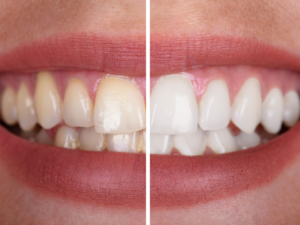
Dental fillings at Irving dentist Dental Concepts play an important role in improving oral health. They prevent tooth loss by halting the progression of decay. They also restore tooth function and appearance. Fillings are the standard treatment for cavities – small holes – resulting from tooth decay. They can also be used to repair a chipped or fractured tooth.
A filling is one of the most commonly performed procedures performed by your Irving dentist. Treatment can typically be done in one appointment, and is more affordable than a dental crown, which is used to repair larger areas of decay. Fillings typically last several years, although not as long as crowns.
Types of Dental Fillings
Several types of fillings can be used to repair a damaged tooth and protect it from further decay.
These include:
- Gold fillings. Cast gold fillings are highly robust and durable. Some people favor gold fillings for aesthetic reasons, but they’re one of the most expensive types of fillings and the procedure takes longer.
- Glass fillings. Glass ionomer fillings consist of glass particles and acrylic. They’re weaker than other fillings and generally used for small cavities near the gumline, rather than on chewing surfaces.
- Ceramic fillings. Like gold fillings, ceramic fillings are expensive but durable and aesthetically attractive. They’re made with tooth-colored ceramic that resists stains.
Most often, however, fillings are made from a silver alloy or a composite material.
Silver Fillings
Silver amalgam fillings are often the least expensive option. They’re stronger and more durable than a composite filling, although they don’t match natural tooth color. The amalgam consists of around 50 percent mercury, which binds together the silver, zinc, tin and copper in the filling.
Despite some health concerns about the toxic properties of mercury, the Food and Drug Administration (FDA) and American Dental Association (ADA) both say the low levels of mercury in metal fillings are safe for the general population.
Sometimes, a certain amount of healthy tooth structure may need to be removed to create enough room to hold a silver filling. Silver fillings usually last 10 to 15 years, and they’re more resistant to future decay than composite fillings.
Composite Fillings
Tooth-colored composite fillings, also known as white fillings, have become increasingly popular because they provide a better aesthetic restoration. They’re made from a ceramic and plastic compound that replicates the sheen and shade of teeth and blends seamlessly for a natural appearance. This is why they’re routinely used in the more visible areas of the mouth.
The resin component of a composite filling provides strong adhesion to the tooth surface and allows for the maximum amount of healthy tooth structure to be preserved. Composite fillings can also be used to change the size and shape of teeth to enhance smiles. The composite filling procedure is more involved than getting a metal filling, so takes longer. A composite filling usually lasts five to seven years.
The Dental Filling Procedure
The dental filling procedure is in most cases preceded by application of local anesthetic to numb the area and minimize discomfort. The filling process begins with removal of decayed tooth structure, which requires penetrating the outer, enamel layer of the tooth.
After removal of decay, your dentist will thoroughly clean the space inside the tooth to ensure elimination of infection. The filling material is then applied, and finally your dentist will polish the tooth to a smooth, shiny finish.
With the composite filling procedure, an acidic gel is used to etch exposed surfaces to help adhesion of the filling to a bonding agent that’s hardened (cured) with a special blue light. The filling material is then applied in layers and cured with the blue light.
How Tooth Decay Is Removed
Your Irving dentist can remove diseased areas of a tooth with a dental a drill, a laser, or air abrasion.
Dental Drilling
Two types of drills are used in the filling procedure:
- A high-speed drill to cut through tooth enamel to access the diseased area.
- A lower-speed drill to remove the decay.
Laser dentistry and air abrasion avoid the need for anesthesia because no drilling is involved.
Laser Dentistry
A laser (Light Amplification by Stimulated Emission of Radiation) uses lightwave energy to vaporize decay (caries).
Air Abrasion
Air abrasion (microabrasion) removes diseased tooth tissue by directing a high-pressure stream of fluid and aluminum oxide or silica particles onto the tooth.
How Are Cavities Diagnosed?
Cavities – the most common reason people need a dental filling – are the result of tooth decay caused by oral bacteria. These microbes feed on sugar in the foods and drinks we consume and produce lactic acid as a byproduct. This acid eats away at tooth enamel and the underlying dentin.
Your Irving dentist diagnoses cavities by looking for signs of decay such as discolored spots on teeth. They’ll also use a dental probe and X-rays to identify cavities and the extent of decay. The probe is a sharp-tipped metal instrument that detects softened dental enamel. An X-ray reveals decay developing in the dentin layer beneath the enamel and in the enamel on the sides of teeth.
Other methods of diagnosing cavities include:
- Applying a dye that rinses off healthy teeth but adheres to decayed areas.
- Laser fluorescence – small wands that measure changes caused by decay.
Can Cavities Be Prevented?
The risk of cavities developing from tooth decay can be greatly reduced if you practice good oral hygiene – flossing as well as brushing – and see your dentist regularly for checkups and professional cleanings. Limiting sugary and acidic foods and drinks, and drinking plenty of water, also helps to keep cavities at bay.
Preventive dentistry in the form of dental sealants and fluoride treatments can lessen the risk of cavities in the pits and fissures of molars and premolars. If you’re a smoker, kicking the habit will benefit your oral health as well as your overall wellbeing.
How Do You Know You Need a Dental Filling?
Dental decay initially doesn’t result in many symptoms. However, if you experience any of the following problems, you should contact your Irving dentist for a consultation.
Your tooth feels rough.edule a consultation with Dental Concepts & Orthodontics.
Tooth sensitivity – discomfort when you chew food or consume hot or cold foods or drinks, or sweet, sticky or sour foods.
An existing filling has broken or fallen out.
You can see a dark spot or a small hole in a tooth.







